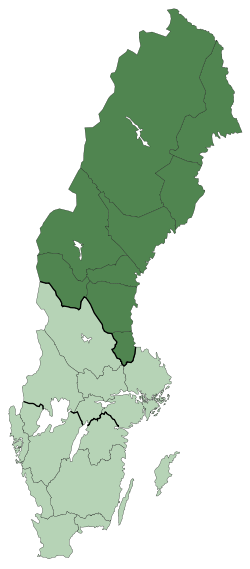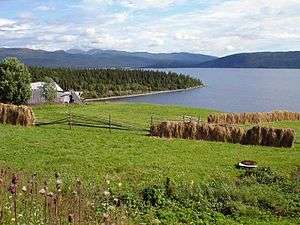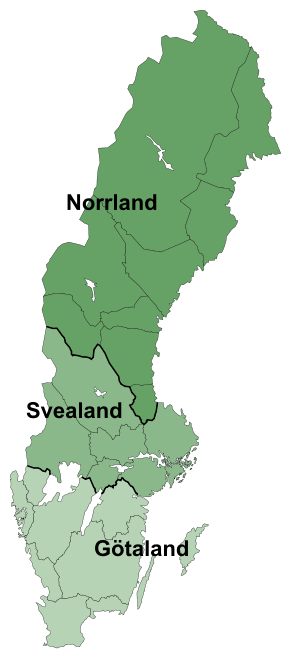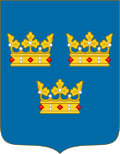Norrland
Norrland (Swedish: [ˈnɔ̌rːland] (![]()
Norrland | |
|---|---|
 | |
| Coordinates: 63.1833°N 14.6667°E |
Provinces and counties
Norrland comprises the historical provinces (landskap) Gästrikland, Medelpad, Ångermanland, Hälsingland, Jämtland, Härjedalen, Västerbotten, Norrbotten and Lappland, roughly 59 percent of Sweden's total area.[1] Historically, Jämtland and Härjedalen belonged to Norway until 1645, and are thus often considered outside of the historical Norrland.
Administratively, Sweden is not divided into provinces but into counties (Län). Although Norrland is defined in terms of the historical provinces and not the counties, it roughly comprises the modern counties of Gävleborg, Jämtland, Norrbotten, Västerbotten and Västernorrland.
Sometimes, Norrland is subdivided into Northern Norrland (norra Norrland) and Southern Norrland (södra Norrland). The northern part of the region typically covers the historical provinces of Norrbotten, Västerbotten and Lappland (the modern counties of Norrbotten and Västerbotten), while the southern part covers the remainder of the region.
Geography

Except for the coastal areas, Norrland is sparsely populated. Approximately 12 percent of Sweden's population lives in Norrland.[2] Except for some coastal areas most of Norrland is made up by the Norrland terrain – hilly and mountainous land covered by boreal forests.[3][4] More in detail Norrland is made up of three north-south belts: the Scandinavian Mountains in the west, the Muddus Plains covering much of the inland, and the mixed relief[upper-alpha 1] of the eastern coast.[5]
Unlike the much more densely populated Svealand and Götaland, which are better known for big cities (Stockholm, Gothenburg, Malmö) with landmarks and tourist attractions, Norrland is known for its nature: wide forests, large rivers and untouched wilderness.
Most inhabitants live in rural areas and small villages, and in cities along the coast. Towards the end of the 20th Century there was a noticeable increase of the population in Norrland, mainly from people moving from bigger cities. The largest cities in Norrland, from north to south, are Luleå, Skellefteå, Umeå, Östersund, Sundsvall and Gävle. With the exception of Östersund, all these cities are located near the coast.
During the industrial revolution, which reached Sweden in the mid-19th Century, Norrland became the source for the important wood and pulp industry. All of the major Norrland rivers but four have been exploited for water power. The rivers in Norrland account for the bulk of hydroelectric power in Sweden – in many countries a limited energy source, but in Sweden hydroelectrical power accounts for approximately 40 percent of Sweden's total production of electricity.
Mines for producing precious metals have also been located in Norrland. In older history and still today, the administration in Stockholm viewed Norrland pretty much as a colony consisting of natural resources to be exploited. "In Norrland we have an India within our borders, if only we realize we should be taking advantage of it" (I Norrland hava vi inom våra gränser ett Indien, blott vi förstå att bruka det) is a quote attributed to Axel Oxenstierna that fairly well describes the attitude. In the official history of Sweden not much is written about the northern parts of the country.
Kebnekaise, Sweden's tallest mountain at 2,111 metres (6,926 feet), is located in Lappland in the north of Norrland.
Norrland has a highly variable climate depending on altitude, latitude and distance to water. The southern coastal areas have a humid continental climate, but further north the subarctic climate is abundant, although it in many areas is very mild for that classification, especially in coastal regions. In the mountain ranges the tundra climate can be found with summer temperatures averaging below 10 °C (50 °F), although this is due to altitude and not in populated areas. All low-lying areas of Norrland are below the tree line due to the mild summers, meaning that the boreal forest is dominant.
History
In older history, Norrland is one of the four lands of Sweden. To the west it represented the northern half of Sweden bounded to the south by Svealand and to the east it represented the northern half of Finland – which was then a part of Sweden – bounded to the south by Österland. In Svealand and Götaland, the land boundaries were of major juridical and administrative importance, but this was not the case with Norrland. The name Norrland just gradually became a denomination of everything north of Svealand. Up to the Middle Ages, the northern part of Norrland (Norrbotten and Lappland) was basically a no man's land. The area was sparsely populated by Sami, Kvens and different tribes/people related to the Finns. In the southern part of Norrland, Swedish and Norwegian settlers lived side by side with the Sami population. From the Middle Ages on, the Swedish kings tried hard to colonize and Christianize the area. But it took time – even today, Finnish and Sami minorities live in the northern parts of Norrland and have maintained their culture and customs.
As a result of the changing relations to Finland, the northern borders of Norrland have shifted. While the word Finland originally meant only the southwestern part of what is now Finland (Finland Proper), the border of Norrland was drawn at the rivers Kaakamojoki or, later, Simojoki. This changed when the eastern half of Sweden (Finland) was lost to Russia in 1809, and the new border was drawn at Torne River. The southern border was originally everything north of the Gästrikland province (until the 14th or 15th century a part of Uppland), but since the mid 17th century, Gästrikland is also considered a part of Norrland. The name can be first traced from Karl's Chronicle, explaining how Engelbrekt Engelbrektsson in 1433 sent a letter to Erik Puke requesting assistance to conquer entire Norrland (al norland vnte han honom wolla).
Sport
Three Norrland teams compete at the Swedish Hockey League: Brynäs IF, Skellefteå AIK and Luleå HF. Timrå IK, MoDo Hockey and IF Björklöven are also three popular teams from Norrland except that they play in the second highest league Hockeyallsvenskan also have long traditions within Swedish ice hockey.
Notable Norrland soccer (football) teams include Selånger FK, Sandvikens IF, Gefle IF, Östersunds FK, and GIF Sundsvall.
In fiction
Norrland is sometimes portrayed slightly negatively in Swedish fiction, sometimes being a place of terror and dread. The thriller films The Hunters and False Trail (The Hunters 2) show a highly negative portrait of Norrland, filled with racial prejudice and violence. The people of Norrland in their turn tend to have a fairly negative view of people from Stockholm and the rest of southern Sweden, for example by referring to Stockholm as "fjollträsk", which loosely translated means "sissy town". This dynamic is portrayed in movies and series such as Sällskapsresan 2 – Snowroller, The Hunters and Pistvakt – En vintersaga. Despite Norrland being the most diverse of the three lands of Sweden in terms of languages and cultures it is usually portrayed as one homogeneous region. Fiction usually portrays characters from Norrland as villagers from the wilderness even though the majority of the population live in and around the coastal cities.
In the 2006 horror film Frostbite, the portrait is more balanced. Unlike most other Swedish films, it takes place in a larger community at the northern peak of Sweden, being filmed in Kalix and Kiruna. The people are shown to be pretty warm and welcoming towards outsiders. Rather than the people, the nature of Norrland is shown to be hostile. A constant darkness roams over the town and there is extreme cold. Vampires have been shown taking a liking to the land and hunt the towns people in the arctic night. The film is notorious for having the actors speak without the district Norrland accent, even the actors in the film who are native to Norrland.
A mixed portrait of the region is found in As It Is in Heaven (2004), which "vividly conveys both the delights and the challenges of small town living."[6] The northern town is initially inhospitable to the main character as a boy, whose mother chooses to take him out of the town to escape bullying. He returns years later as an accomplished musician, only to find an insular town where bullying continues in several forms, including from the original classmates who troubled him as a youth. It is through his outside status -- along with his music and desire share its joy -- that the town finds redemption.
The plot of the well-known thriller The Girl with the Dragon Tattoo shifts back and forth between Stockholm and the fictional Norrland town of Hedestad. A constantly repeated theme in the book's background are the social, cultural and physical differences between these two locations: Norrland is more sedate, conservative and slow-moving in comparison with the cosmopolitan Stockholm; a Stockholmer having to live for an extended period in Norrland feels "exiled to the back of beyond"; Norrland is also colder, and a Stockholmer coming there must urgently buy warmer clothes (a theme highlighted also in As It Is in Heaven); Norrlanders often speak regional dialects which Stockholm people find nearly incomprehensible; Stockholm people look down their noses at "a working class boy from Norrland" even when he had lived many years in Stockholm. The book's great success and translation into numerous languages made non-Swedish people more aware of Norrland and its special characteristics.
See also
- Svealand
- Götaland
- Österland
- Upper Norrland
- Middle Norrland
- Sápmi
- Lappland
- Historical provinces of Finland
- Norrland Grand Regiment
- Norrland County
- Norland (disambiguation)
- Nordland (disambiguation)
Notes
- This includes coastal plains and parts of the Sub-Cambrian peneplain.[5]
References
- article Norrland from Nordisk familjebok. In Swedish.
- "Norrland | region, Sweden". Britannica.com. Encycopaedia Britannica. Retrieved 5 February 2018.
- Population of Sweden 2008-12-31 Archived 2010-08-20 at the Wayback Machine, Statistics Sweden
- Lidmar-Bergströrm, Karna (1995). "Relief and saprolites through time on the Baltic Shield". Geomorphology. Elsevier. 12: 45–61.
- Sporrong, Ulf (2003). "The Scandinavian landscape and its resources". In Helle, Knut (ed.). The Cambridge History of Scandinavia. Cambridge University Press. pp. 22.
- Lidmar-Bergström, Karna (2002). "Berggrundens ytformer". In Fredén, Curt (ed.). Berg och jord. Sveriges Nationalatlas (in Swedish). Sveriges Nationalatlas. pp. 44–54. ISBN 91-87760-50-9.
- Brussat, Frederic; Brussat, Mary Ann. "An astonishing Swedish drama about a church choir and its creative director who take a meaningful and loving journey together". Spirituality & Practice. Retrieved 2017-01-24.
External links
| Wikivoyage has a travel guide for Norrland. |
![]()

